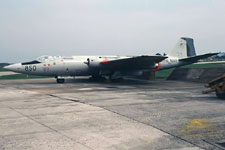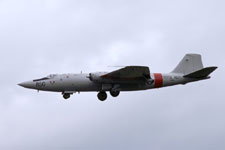| WH801's service history
English Electric Canberra WH801 was built by English Electric at its Warton factory, after it was ordered by the Royal Air Force as a PR.3 variant.
However, the aeroplane was brought up to the superior PR.7 specification on the production line and was declared ready for collection by its owners on 28th May 1954. WH801 became a part of the newly formed RAF 540 Squadron (Sqn) at RAF Wyton in Cambridgeshire, and was later transferred to RAF 58 Sqn at the base, although unfortunately dates and times served with each Unit are unavailable at the time of writing.
WH801 then saw service with RAF 13 Sqn, based in Cyprus at RAF Akrotiri, and flew numerous photographic reconnaissance sorties during the Suez conflict, codenamed "Operation Musketeer" in 1956. During one such sortie, WH801 and three other Canberra aeroplanes were incepted by an Egyptian Air Force MiG 15 fighter, with WH801 sustaining damage after being shot at. The aeroplane was later transferred to RAF 31 Sqn at Laarbruch in West Germany, before ending its Squadron service with RAF 17 Sqn at Wahn, also part of the RAF Germany Canberra force. In December 1969, RAF 17 Sqn disbanded, and its aeroplanes were returned to the UK and placed in long-term store.
During 1971, the Royal Navy was in need of a new radar trainer for its Fleet Air Arm, and the Canberra PR.7 became the basis of the 'new' variant, the T.22.
WH801 was one of seven airframes transferred to Royal Navy charge at RAF St Athan on 15th February 1971, and following the completion of design work carried out by Marshalls of Cambridge, each airframe was moved to the British Aircraft Corporation's (BAC) Salmesbury airfield for conversion. WH801 arrived in July 1971, and two years later was ready for service entry.
The aeroplane, now fitted with Blue Parrot radar and avionics used in the Blackburn Buccaneer, became the first T.22 to enter military service on 16th November 1973, when it arrived at RNAS Yeovilton to join the Fleet Requirements and Air Direction Training Unit (FRADTU).
Assigned the fleet number '850' and used for airborne radar instruction, WH801 remained in service until June 1976, when it was grounded for a major inspection.
A year later in July 1977, it rejoined the FRADU (the word Training had been dropped from the Unit's title) and was operated without major incident for the next eleven months, until the navigator's window was damaged mid-flight, which resulted in repairs having to be carried out at RAF St Athan.
It was returned to Fleet Air Arm service in April 1979, and WH801 was active (aside from a further period of store/major inspection between May 1983 and December 1984) with FRADU until 6th September 1985, when it was retired from service after its role was taken over by civilian owned and registered Falcon 20 business jets. Now redundant, WH801 was ferried to RAF St Athan and placed in long-term store, where it would remain for six years until it was offered for disposal in May 1991. |

[© Eroc Tammer]

[© Lindsay Peacock]

[© Ian Powell]
|